cell membrane
1/62
There's no tags or description
Looks like no tags are added yet.
Name | Mastery | Learn | Test | Matching | Spaced |
|---|
No study sessions yet.
63 Terms
Membranes are made of —
lipids
t or f
Proteins are a component of membranes
t
• Proteins are involved with moving — across membranes
molecules
• Cells are surrounded by a membrane that—
separates the contents of a cell from the external environment
what is the point of having a cell membrane?
Contains and protects cellular contents, otherwise you’d just have soup
describe what a cell membrane looks like
bilayer of lipids with the polar heads on the outside and the inside has the lipid tails
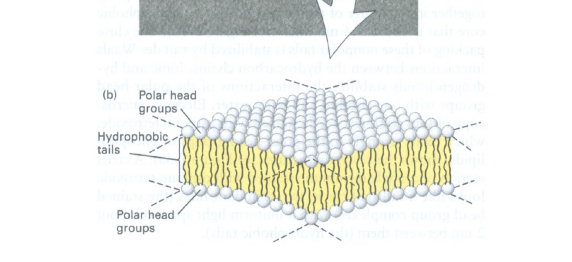
can lipids can make other biologically relevant structures other than bilayer membranes?
yes
name 3 other biologically relevant structures that lipids can make
Micelle •
Extracellular vesicles (EV)
• Liposome
liposomes are normally man-made, but what do they resemble more?
a) micelles
b) extracellular vesicles
b) extracellular vesicles (double lipid bilayer)
describe the structure of a micelle
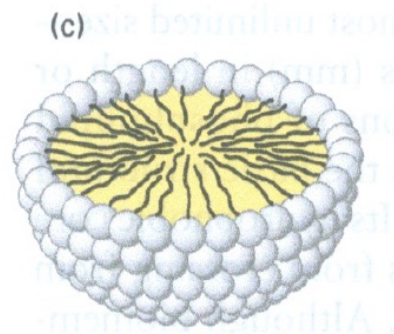
describe the structure of a liposome
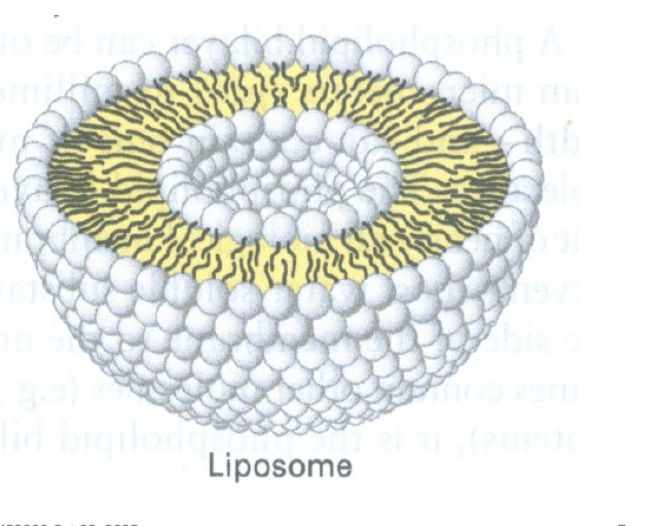
what were liposomes used for?
vaccines, covid vaccine used rna inside liposome because it doesnt mater where Rna gets expressed, it will make antigens
what was the problem for liposomes in drug delivery?
The liposome would always get taken up by the liver first
why can an etxracellular vesicle trasnport things like rna, dna, drugs but a micelle cannot?
the stuff its transporting is actually in the middle, so its non polar there
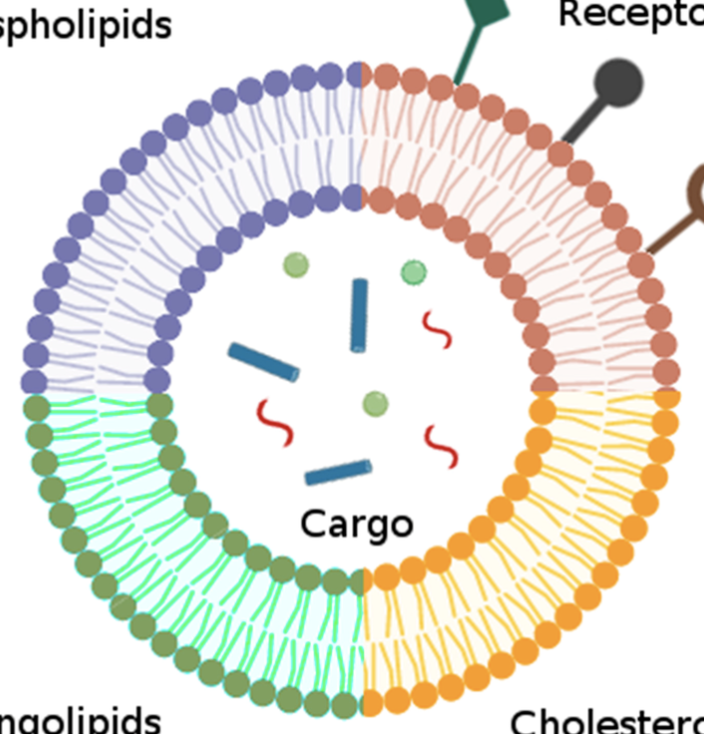
what unique thing do phosphoglycerides have in them
glycerol
what unique thing do sphingolipids have in them?
sphingosine
what unique thing do sterols have in them?
rings
do all species have the same membrane lipid composition?
no
whats one big difference between humans and e coli lipid membranes?
e coli have no cholesterol
t or f
even human membranes depending on where they are they have different compositions
t
different thicknesses, different levels of fluidity uh and different shapes are acheived by—
different lipid compositions change the structure
t or f
even if you're looking at the same cell, it's not going to have the same exact same lipid composition at all parts of that surface
t
in what ways can lipids move within a membrane? (they’re not static)
they can flip flop to the other leaflet (rare)
they can rotate around
they can do lateral diffusion
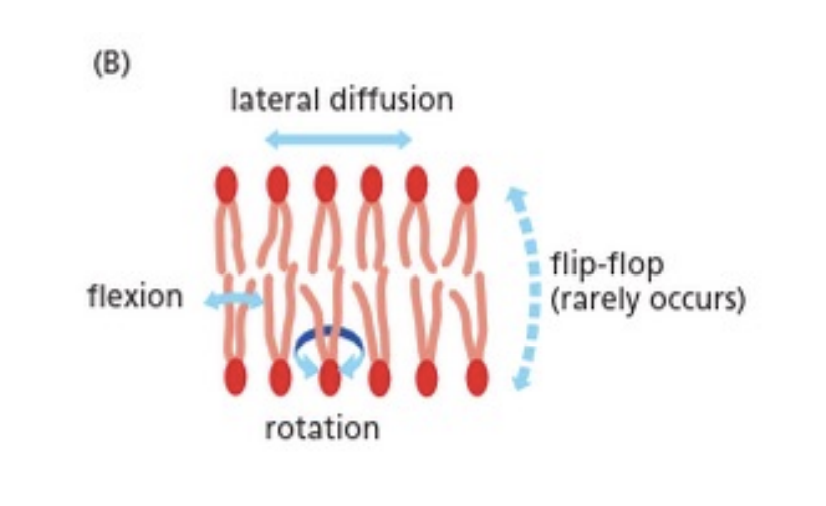
what is one way he mentioned to study the movement of lipid membranes
photobleaching
explain the photobleacing thing
Label lipids (or proteins) in the cell membrane with a fluorescent tag.
Photobleach a small region with a focused laser beam (this destroys fluorescence only in that area).
If the lipids move around then this patch shouldnt exist anymore, theyll get spread out
this means that the fluorescence in that bleached area should return cause its not all concentrated in one area anymore
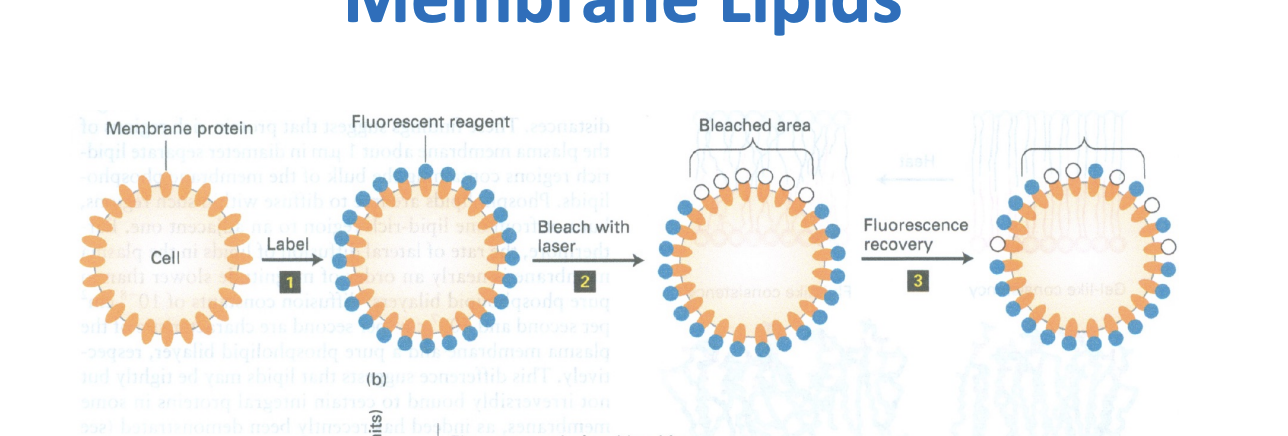
In addition to the cell surface membrane, cells have many internal membranes, name 5
• Nuclear membrane
• Mitochondria
• Endoplasmic reticulum
• Golgi
• Lysosomes
t or f
There's not the same lipid composition on both sides of the lipid bilayer leaflets
t
different needs for different environments and communication
• Excess hydrophobic lipids in cells can be stored as —
droplets
fats accumulate inside the membrane of the Endoplasmic reticulum, then what happens to them?
they bud off into the CELL CYTOPLASM
not into the ER lumen
thats why he says “droplets are generated from membranes”
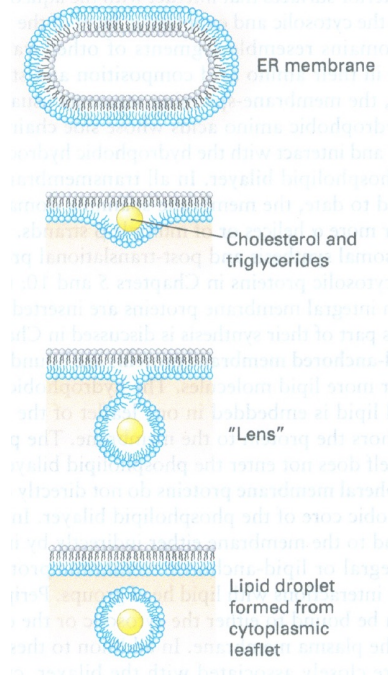
membranes need to contain a cell and stop things from getting in and out, but why is it bad to do that TOO much?
because you need some things to get in and out like nutrients and waste out and you need communication
what are 3 examples of things that are permeable through the cell mebrane?
carbon dioxide
oxygen
ethanol
most sugar and proteins are impermeable to the cell membrane, so how do they get in?
through the proteins that are in the membrane surface
name a few ways proteins can be associated with the cell membrane
channels
trasnporters
receptors
some are just associated with the membrane or other proteins
in simple channels, what is the flow of movement
Molecules move with the concentration gradient (passive, no ATP)
Uniporters
Transport single type of molecule with the gradient
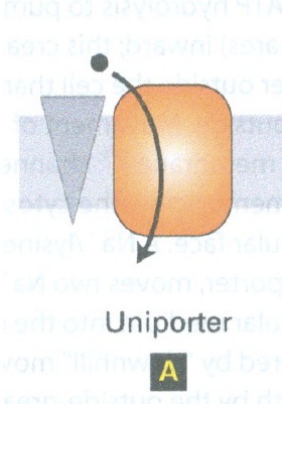
explain a symporter
you want to move one molecule in but its against its concentration gradient
proteins have evolved to let that molecule of interest hitch a ride on a molecule thats coming in WITH its concentration gradient
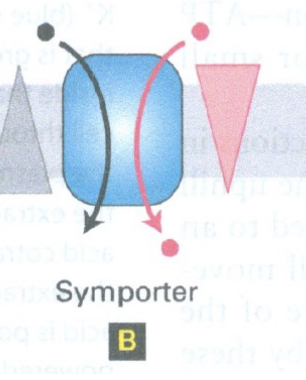
antiporter
Catalyze movement of one molecule against a gradient, driven by a second molecule going WITH its gradient – molecules move in opposite directions
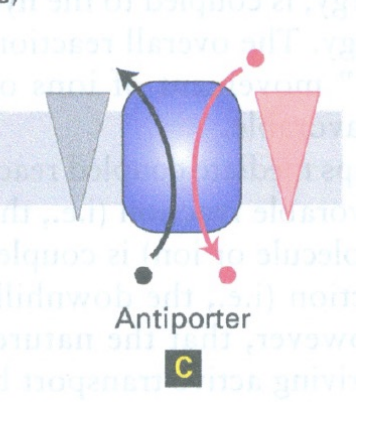
explain how pumps work
it breaks down ATP (hydrolysis) to generate energy to allow the movement of a molecule against its gradient
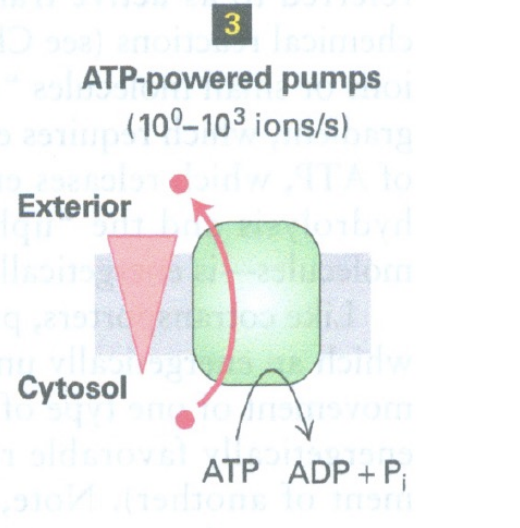
why is secreting proteins such a focus?
because proteins are usually hydrophilic or hydrophobic, so it dfeintely wont want to move ACROSS a membrane, either it wont want to go near it, or it will want to stay in it
thats why the cell needed to evolve these secretion pathways to find ways to get proteins In and out of cells
if you have a ribosome freely floating in the cytoplasm, it will make a — protein
cytosolic (stays in cytoplasm, or is hydrophylic at least, I think)
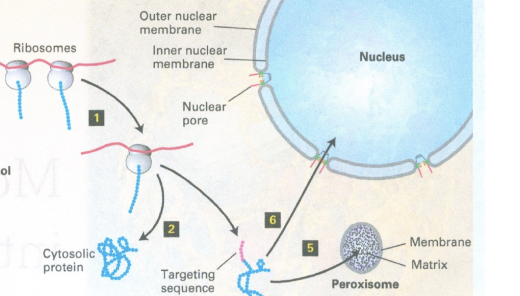
if you want to make a protein that needs to get across a membrane, whats something you could do?
use an attached ribsosome that gets secreted into lumen directly
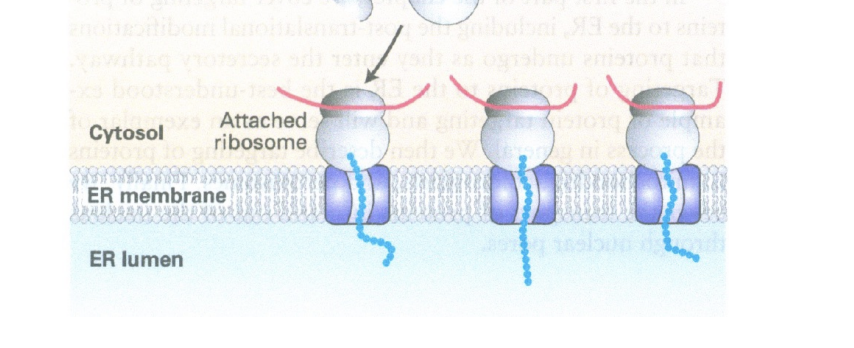
So if a protein is to be secreted using the canonical secretion pathway, ribosomes attach the first attach the mRNA start to translate. It produces an —
end terminal peptide which is a signal peptide
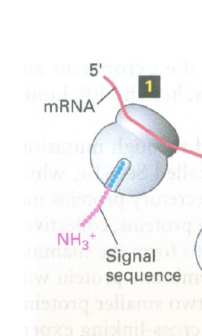
. what happens with this signal recognition peptide?
it is recognized by a signal recognition protein
what happens when the signal recognition protein recognized the signal sequence?
it directs that ribosome to the endoplasmic reticulum
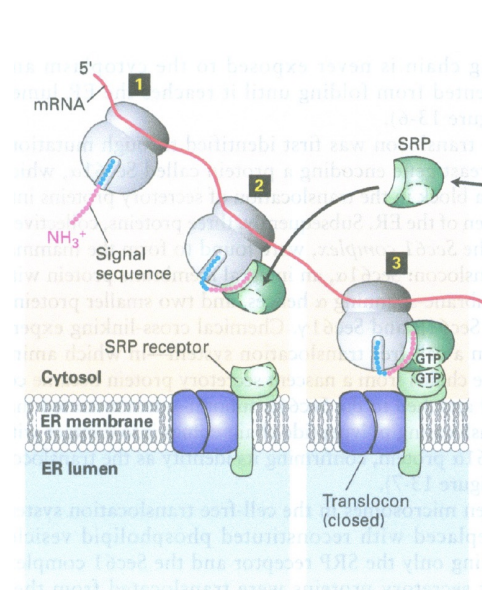
this signal recognition protein is not just made out of protein. It also contains an RNA called the 7 SL RNA which is also Important for.
the Alu repetitive DNA element which is found super freqeuntly in the genome, is derived from this RNA
So the docking of the signal recognition protein with proteins on the endoplasmic reticulum allows —
insertion of the newly synthesized AA chain (signal sequence) through the translocon
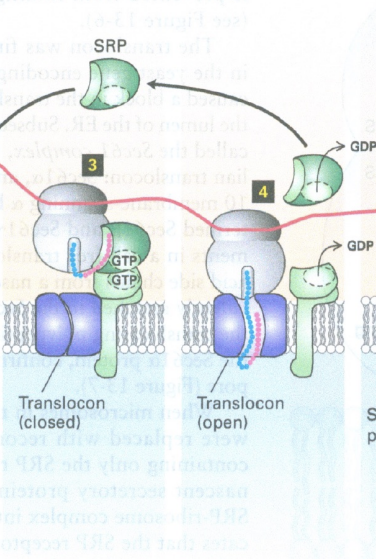
Once that signal sequence comes through the translocon, what happens?
the signal peptide is immediately cleaned off by the protein signal peptidase
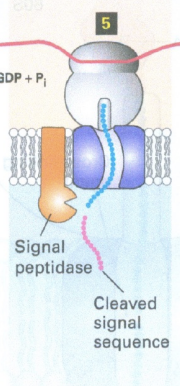
t or f
If it's going to be a secreted protein, it's generally modified
t
glycolsylation is common
if you see a protein with a lot of disulfide bridges, what can you assume about it?
that it is a secreted protein (extracellular, like hormones, insulin, albumin, collagen) because intracellular proteins don’t have a lot of them
okay so it can be glycosylated, disulfide bridge, whats one more thing he mentioned that can happen to modify?
proteolytically processed
when hes talking about transmembrane proteins, which end of the protein is usually inside the cell and which end is usually outside the cell?
N terminus usually OUTside
C terminus usually inside
thats why he thought type 2 were so weird

whats different about secreted proteins to type 1 proteins? like how do they get stuck in the membrane?
they have a hydrophobic part of their chain which acts as a “stop trasnfer” signal to the translocon, so the rest of tit never goes through
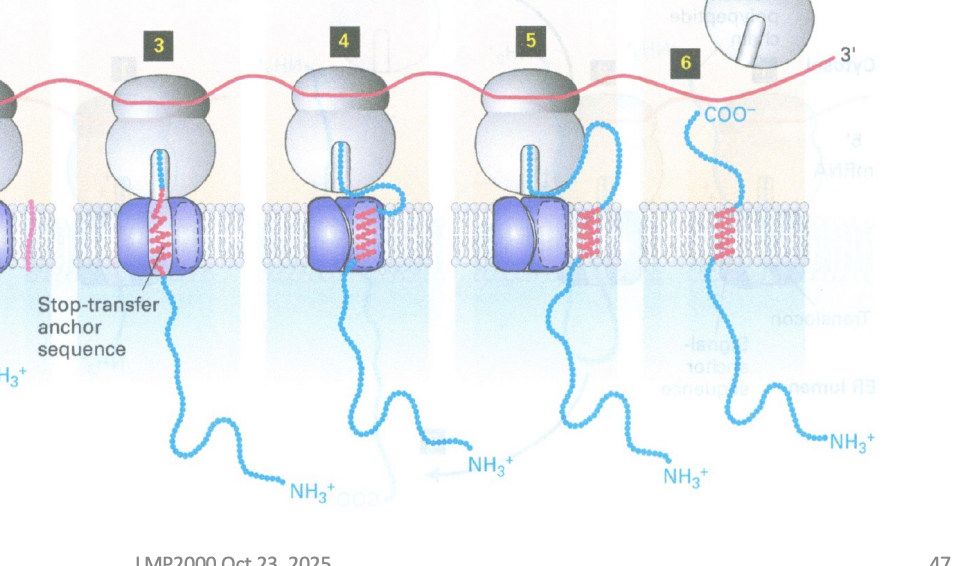
explain what happens with type 2 membrane proteins
free ribsome starts trasnlating
then theres a “signal anchor sequence” which is hydrophobic
this drags it to the translocon
it cant put the N terminal end in because its too far away now
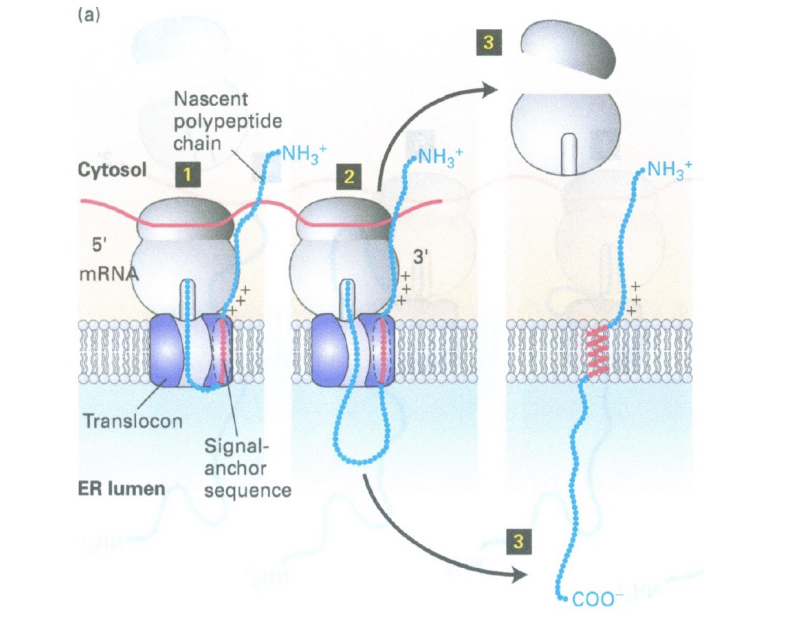
how do you get a type 3?
its like type 1 but the hydrophobic sequence is very early on so most of it doesnt go through
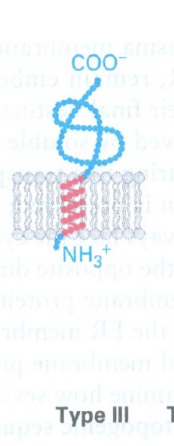
how do you get type 4?
it starts like a type 2 but the hydrophoic signal is very late, so the whole thing almost gets trasnlated first
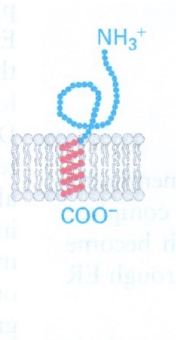
t or f
type 2 and 3 (and 4 I think) have Cytosolic translation initially
true
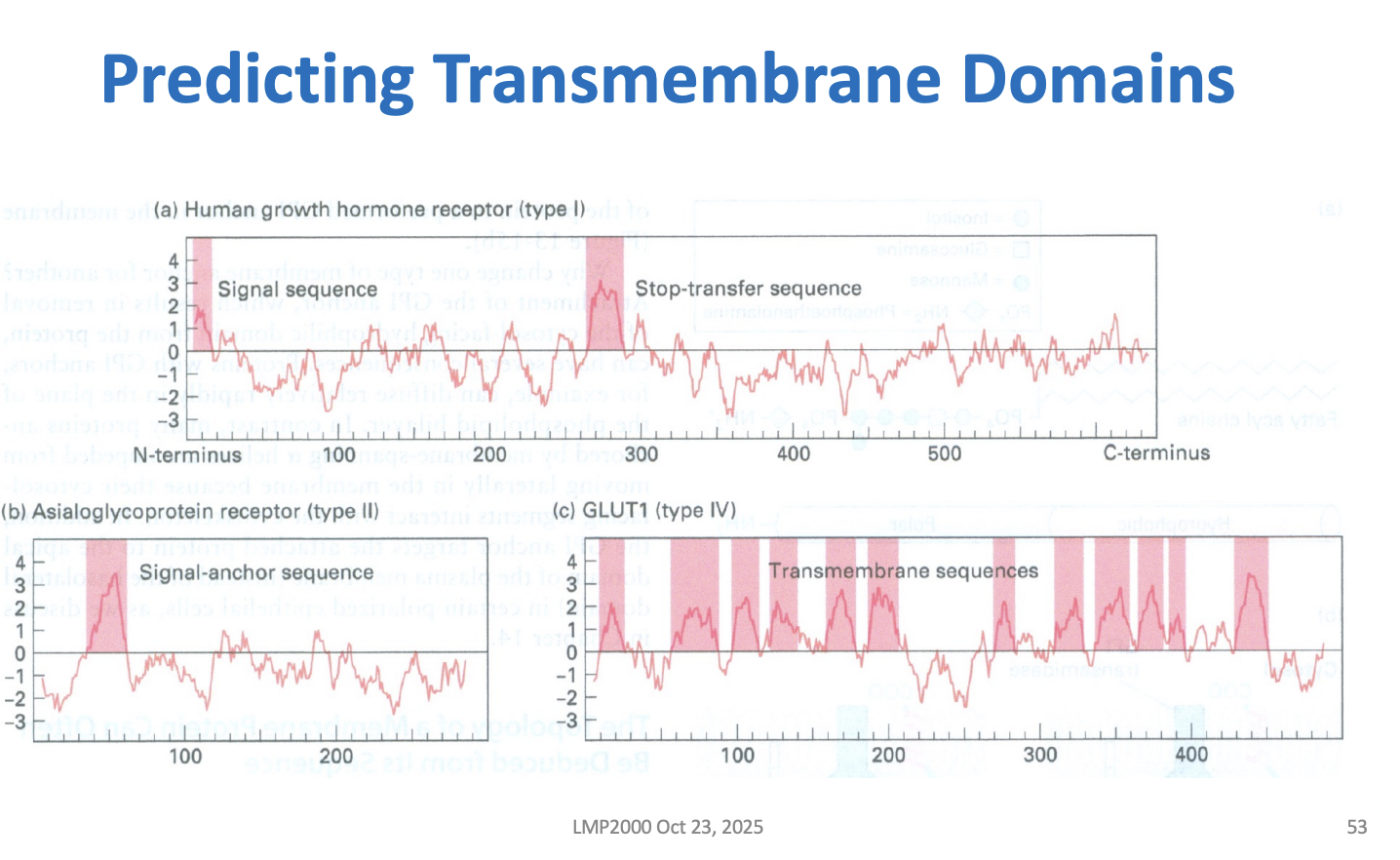
when hes showing you this slide, what is he referring to, Iike what are you predicting?
by looking at the sequence, you can see if it has
stop trasnfer sequence
where/if hydrophobic anchor sequence
so , this helps you determine the shape of the protein and where it will be
what does he mean when he says that some membranes funciton as fucntional sites?
like the inner mitochondrial membrane is the site where ATP is produced
what does he mean by internal membranes?
• Nucleus • Mitochondria • Lysosomes
t or f
the nuclear membrane and the endopplasmic reticulum are actually attached to each other.
t
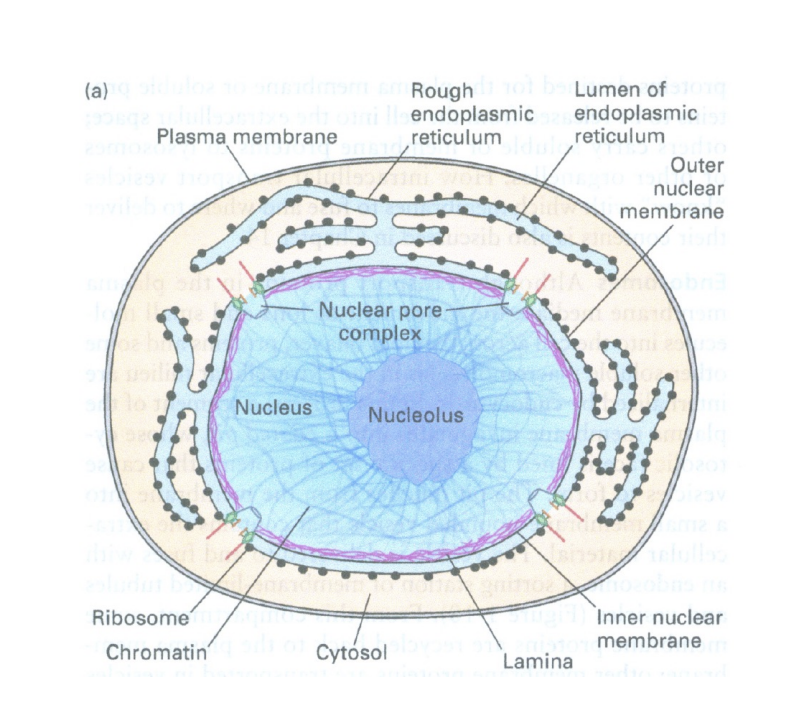
okay so eukaryotes have these internal membranes right like nucleus and mitochondria, but prokaryotes have NO internal membranes right like no nucleus
right right
whats the hypothesis for how the nucelur enveloppe came about?
a prokarrotic cell started getting plasma membrane invaginations in such a way that surrounded the nucleus to protect it
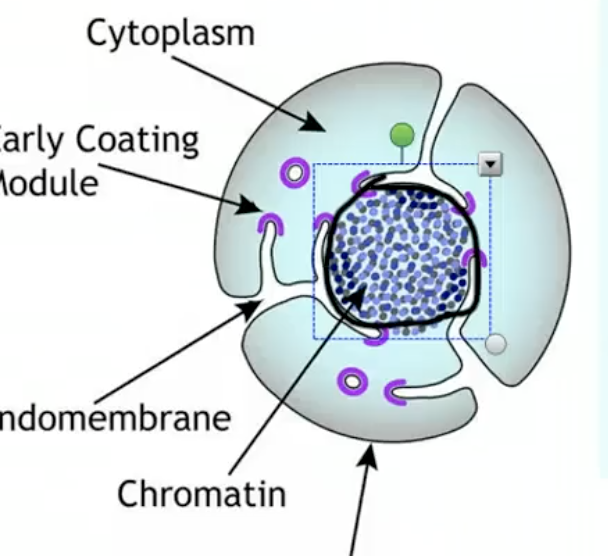
whats the hypothesis for how mitochondria came about?
early prokaryote (or maybe the same cell that just got the nucelus?) engluphed a bacteria which becomes the mitochondria
because it engulphed it, it was put isnide a vesicle whihc became its second membrane